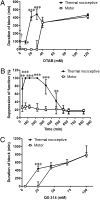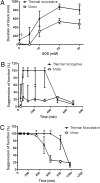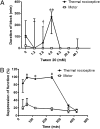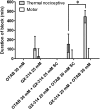Prolonged sensory-selective nerve blockade
- PMID: 20133669
- PMCID: PMC2840479
- DOI: 10.1073/pnas.0911542107
Prolonged sensory-selective nerve blockade
Abstract
Sensory-selective local anesthesia has long been a key goal in local anesthetic development. For example, it allows women to be pain-free during labor without compromising their ability to push. Here we show that prolonged sensory-selective nerve block can be produced by specific concentrations of surfactants-such as are used to enhance drug flux across skin-in combination with QX-314, a lidocaine derivative that has relative difficulty penetrating nerves. For example, injection of 25 mM QX-314 in 30 mM octyltrimethylammonium bromide (OTAB) lasted up to 7 h. Sensory selectivity was imparted to varying degrees by cationic, neutral, and anionic surfactants, and also was achieved with another lidocaine derivative, QX-222. Simultaneous injection of OTAB at a s.c. injection site remote from the sciatic nerve did not result in prolonged sensory-specific nerve blockade from QX-314, suggesting that the observed effect is due to a local interaction between the surfactant and the lidocaine derivative, not a systemic effect.
Conflict of interest statement
The authors declare no conflict of interest.
Figures







Similar articles
-
The quaternary lidocaine derivative, QX-314, produces long-lasting local anesthesia in animal models in vivo.Anesthesiology. 2007 Aug;107(2):305-11. doi: 10.1097/01.anes.0000270758.77314.b4. Anesthesiology. 2007. PMID: 17667576
-
The quaternary lidocaine derivative QX-314 in combination with bupivacaine for long-lasting nerve block: Efficacy, toxicity, and the optimal formulation in rats.PLoS One. 2017 Mar 23;12(3):e0174421. doi: 10.1371/journal.pone.0174421. eCollection 2017. PLoS One. 2017. PMID: 28334014 Free PMC article.
-
Duration and local toxicity of sciatic nerve blockade with coinjected site 1 sodium-channel blockers and quaternary lidocaine derivatives.Reg Anesth Pain Med. 2012 Sep-Oct;37(5):483-9. doi: 10.1097/AAP.0b013e31826125b3. Reg Anesth Pain Med. 2012. PMID: 22914659 Free PMC article.
-
Emulsified isoflurane enhances thermal transient receptor potential vanilloid-1 channel activation-mediated sensory/nociceptive blockade by QX-314.Anesthesiology. 2014 Aug;121(2):280-9. doi: 10.1097/ALN.0000000000000236. Anesthesiology. 2014. PMID: 24667830
-
[Peribulbar anesthesia versus retrobulbar anesthesia with facial nerve block. Techniques, local anesthetics and additives, akinesia and sensory block, complications].Klin Monbl Augenheilkd. 1994 Feb;204(2):75-89. doi: 10.1055/s-2008-1035503. Klin Monbl Augenheilkd. 1994. PMID: 8170098 Review. German.
Cited by
-
Topical drug formulations for prolonged corneal anesthesia.Cornea. 2013 Jul;32(7):1040-5. doi: 10.1097/ICO.0b013e31828cbfe6. Cornea. 2013. PMID: 23615270 Free PMC article.
-
An in Vivo Mouse Model to Investigate the Effect of Local Anesthetic Nanomedicines on Axonal Conduction and Excitability.Front Neurosci. 2018 Jul 26;12:494. doi: 10.3389/fnins.2018.00494. eCollection 2018. Front Neurosci. 2018. PMID: 30093852 Free PMC article.
-
The quaternary lidocaine derivative QX-314 produces long-lasting intravenous regional anesthesia in rats.PLoS One. 2014 Jun 16;9(6):e99704. doi: 10.1371/journal.pone.0099704. eCollection 2014. PLoS One. 2014. PMID: 24932639 Free PMC article.
-
Quaternary Lidocaine Derivatives: Past, Present, and Future.Drug Des Devel Ther. 2021 Jan 14;15:195-207. doi: 10.2147/DDDT.S291229. eCollection 2021. Drug Des Devel Ther. 2021. PMID: 33469271 Free PMC article. Review.
-
Acid solution is a suitable medium for introducing QX-314 into nociceptors through TRPV1 channels to produce sensory-specific analgesic effects.PLoS One. 2011;6(12):e29395. doi: 10.1371/journal.pone.0029395. Epub 2011 Dec 28. PLoS One. 2011. PMID: 22216270 Free PMC article.
References
-
- Binshtok AM, Bean BP, Woolf CJ. Inhibition of nociceptors by TRPV1-mediated entry of impermeant sodium channel blockers. Nature. 2007;449:607–610. - PubMed
-
- Courtney KR. Mechanism of frequency-dependent inhibition of sodium currents in frog myelinated nerve by the lidocaine derivative GEA. J Pharmacol Exp Ther. 1975;195:225–236. - PubMed
Publication types
MeSH terms
Substances
Grants and funding
LinkOut - more resources
Full Text Sources
Other Literature Sources

